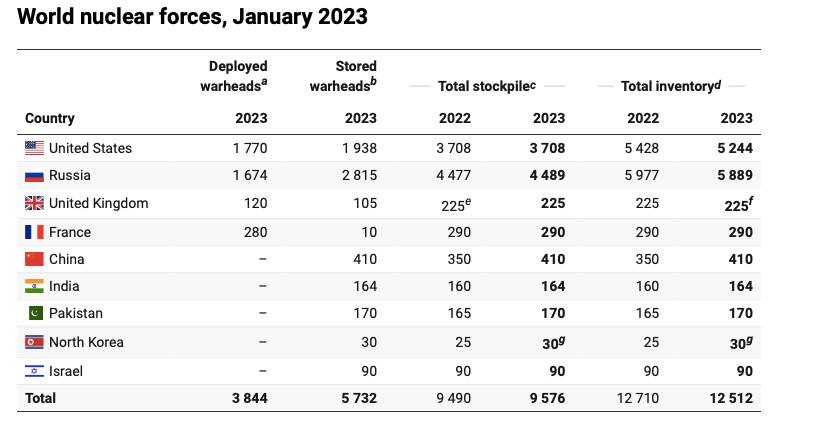The Stockholm International Peace Research Institute (SIPRI) recently released its annual Yearbook, providing valuable insights into the state of global nuclear arsenals. This article highlights SIPRI’s key findings, focusing on China’s nuclear expansion, India and Pakistan’s growing arsenals, and general trends observed across the globe.
China’s Nuclear Arsenal:
SIPRI’s assessment reveals that China has significantly increased its nuclear arsenal in contrast to its official position of maintaining the minimum necessary for national security. The report suggests that China’s long-term plans for modernization and expansion have contributed to the growth. According to SIPRI’s estimates, China’s nuclear warheads increased from 350 in January 2022 to 410 in January 2024. Furthermore, SIPRI warns that if China continues on this trajectory, it could potentially possess as many nuclear weapons as the United States or Russia by the end of the decade, depending on its strategic decisions.

Buy Prime Test Series for all Banking, SSC, Insurance & other exams
India and Pakistan’s Nuclear Arsenals:
SIPRI’s Yearbook also highlights the expansion of India and Pakistan’s respective nuclear arsenals. Both countries have been introducing and developing new nuclear delivery systems. The report indicates that Pakistan remains the primary focus of India’s nuclear deterrence policy. However, India has placed more emphasis on long-range weapons, including those capable of targeting locations across China. SIPRI notes that India has completed its nuclear triad by deploying two new ballistic missile nuclear submarines and upgrading its ballistic missiles. Notable additions to India’s arsenal include a submarine-launched intermediate-range ballistic missile and the Agni Prime, expected to replace older Agni missiles in the 1000-2000 km range. India has also inducted the Agni-5, with a range exceeding 5000 km.
Global Nuclear Inventory and Modernization:
SIPRI’s report underscores that the nine nuclear-armed states, including the United States, United Kingdom, Russia, France, China, India, Pakistan, North Korea, and Israel, continue to modernize their nuclear arsenals. Several of these states deployed new nuclear-armed or nuclear-capable weapons systems in 2022. The global inventory of estimated warheads stood at approximately 12,512, with around 9,576 warheads held in military stockpiles for potential use. Notably, the United States and Russia accounted for 90% of the total warheads, although their arsenal sizes remained relatively stable in 2022.
Impact of the Invasion of Ukraine:
SIPRI warns that the transparency surrounding nuclear warheads possessed by Russia and the United States has declined in the aftermath of the conflict in Ukraine. The U.S.A. suspended its bilateral strategic stability dialogue with Russia following the invasion, prompting Russia to suspend its participation in the New START Treaty. This treaty, which expires in 2026, imposed limits on the nuclear strategic forces of both countries. Discussions on a follow-up treaty have also been suspended. However, as of January 2023, SIPRI concludes that the deployed strategic forces of both nations remain within the limits set by the New START Treaty.
Find More Ranks and Reports Here



 Indian Olympic Medal Winners List Till N...
Indian Olympic Medal Winners List Till N...
 Who is the Inventor of the Gramophone?
Who is the Inventor of the Gramophone?
 HS Dhaliwal Appointed New DGP Of Andaman...
HS Dhaliwal Appointed New DGP Of Andaman...
